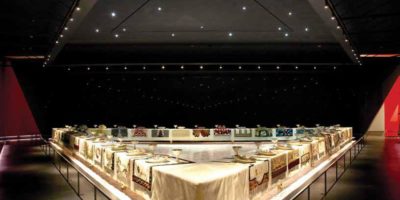Judy Chicago’s Jewish Identity
Her petalled flowers and vulva-like forms, her swirls and gradations of color are signatures of Judy Chicago’s work. We also recognize Judy Chicago today as a significant fulcrum for twentieth-century art. Her explicitly female imagery and equally explicit feminist themes of women’s accomplishments, women’s suffering, birth and female erotic desire, mark a turning point, where abstraction gives way to accessible meaning. And in major exhibitions this year, Judy Chicago is getting the pretty much unfettered admiration and appreciation that has sometimes eluded her in the past.
With “Judy Chicago: Jewish Identity,” on view at the Hebrew Union College-Jewish Institute of Religion Museum in New York until July 2007, the Jewish and Jewish feminist passions that animate her work are boldly manifest, from the wrenching images of “The Holocaust Project,” completed in 1993, a collaboration with her husband, photographer Donald Woodman, to her erotic illustrations demonstrating what she calls “the mutuality of desire” for Marcia Falk’s translation of Song of Songs (1999). Even Chicago’s name gets traced to her Jewish ancestry, says Jean Bloch Rosensaft in the catalog for the HUC show. “Her self-liberating change of name [in 1970] to Judy Chicago (née Judy Cohen, married to Gerowitz) to divest ‘all names imposed upon her through male social dominance’ reflects the city-based surnames that Jews adopted after their Emancipation in 19th Century Europe.”
A lithograph from Chicago’s series “Compressed Women Who Yearn to Be Butterflies” appears to the right; it’s based on George Eliot’s 1876 novel Daniel Deronda, which features a Jewish family. On her drawing Chicago transcribed Mme. Deronda’s cry: “You are not a woman. You may try — but you can never imagine what it is to have a man’s force of genius in you, and yet to suffer the slavery of being a girl. To have a pattern cut out — this is the Jewish woman! This is what you must be; this is what you are wanted for; a woman’s heart must be of such size and no larger, else it must be pressed small, like Chinese feet.”
“Jewish Identity,” mounted by the HUC museum’s curator, Laura Kruger, highlights the collaborative nature of much of Judy Chicago’s artistic output. Not just with the photographic images of Woodman or the words of Falk, but also — strikingly — with hundreds of mostly volunteer craftspeople and needlework specialists who painted china, wove table runners, embroidered and in other ways actually brought to life the designs Chicago had for “The Dinner Party,” “The Birth Project” and other of her works, reminding viewers of the debt that male and female artists owe to Judy Chicago for honoring women’s craft production and elevating it to the status of art, worthy of museum display.
Thanks to Judy Chicago and the other pioneering women who began to define and practice feminist art in the 1970s — most of them Jewish, like late art historian Arlene Raven, artist Miriam Schapiro, graphic designer and educator Sheila Levrant de Bretteville — art expressing an impulse for social justice in a non-doctrinaire way is having its day. In a wide-ranging conversation with Lilith, Chicago said, “The reason feminist art is so difficult for people is that it’s content-based art. The content is women’s experiences, women’s perspective.” And what about those who say feminism is finished? “For most women of the world it is not; it’s a constant.”


